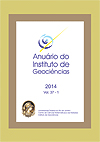Climatological Characterization and Observed Trends in Climatic Extremes in the State of Rio de Janeiro
DOI:
https://doi.org/10.11137/2014_2_123_138Keywords:
Climatology, Climate Change, Rio de Janeiro.Abstract
In this paper it is elaborated a climatology of air temperature and precipitation and an analysis of trends in climate extremes of such variables for the State of Rio de Janeiro, using observational data between 1961 and 2012. The climatology shows average minimum temperatures ranging between 9.5 and 11ºC (15.5 to 17ºC) in winter (summer) in the mountainous region. Higher values occur mainly on the coast, where the average minimum temperature ranges between 17 and 18.5ºC (21.5 to 23ºC) in winter (summer). The lowest average maximum temperatures range between 21.5 and 23ºC (26 and 27.5ºC) in winter (summer) in the mountainous region. The highest values are in the Metropolitan Region and in the North/Northwest area, ranging between 26 and 27.5ºC (32 and 33.5ºC) in winter (summer). The annual rainfall shows maxima in higher areas (about 2500 - 2800 mm per year) and minima in the regions of marshland and coastline (between 700 and 1300 mm per year). For the observed trends in climate extremes of temperature, the Metropolitan Region and the North and Northwest Region of the State indicate statistically significant increases in mean maximum temperature (between +0.01 and +0.08ºC/year). It is also noted significant rise trends in the percentage of warm nights and days in almost the entire State (between +0.1 and +0.6 %days/year). As for rain, it is observed that there is a statistically significant upward trend in the annual rainfall totals in the Baixadas Litorâneas (between +4.0 and +32.0 mm/year). Also, it is verified a significant increase in rainfall totals of more heavy rains in the year in the Baixadas Litorâneas and in part of the Metropolitan Region, with magnitudes between +2.0 and +20 mm/year.Downloads
Download data is not yet available.
Downloads
Published
2017-02-15
How to Cite
Silva, W. L. and Dereczynski, C. P. (2017) “Climatological Characterization and Observed Trends in Climatic Extremes in the State of Rio de Janeiro”, Anuário do Instituto de Geociências. Rio de Janeiro, BR, 37(2), pp. 123–138. doi: 10.11137/2014_2_123_138.
Issue
Section
Article
License
This journal is licensed under a Creative Commons — Attribution 4.0 International — CC BY 4.0, which permits use, distribution and reproduction in any medium, provided the original work is properly cited.















